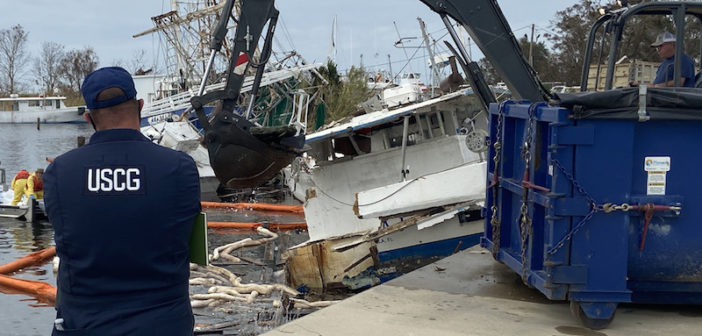Workboat operators in the Gulf of Mexico are no strangers to hurricanes that disrupt navigation and human lives, but 2020 was an especially brutal and relentless season of destructive storms.
When Zeta, a Category 2 hurricane barreled through Louisiana on Oct 28, it was the fifth named storm this year to hit the state, surpassing the previous record of four in 2002 and arriving just weeks after two other devastating storms, Laura and Delta.
Laura made landfall in the state’s southwest corner in late August with 150 mph winds, becoming one of the most powerful storms on record to hit the state. It caused extensive damage and the loss of 27 lives, forced some 8,000 people into emergency shelters, and closed navigational channels and ports. A few days later, with the state barely recovering from Laura, Delta arrived, adding more damage and misery for storm-weary residents and exacerbating damage caused by previous storms.
“This has been extremely unusual,” said John Buchanan, president of Harbor Docking & Towing, a family-owned ship assist harbor tug operator in Lake Charles. “We’ve had active years before, but it seemed like this season there was a storm every week in the Gulf, and that certainly has had an effect.”
In an average year, around 12 named storms form, which could include both tropical storms and full-fledged hurricanes. Federal forecasters had predicted an active season with 13-19 storms and as many as six becoming major hurricanes. Zeta was the 27th named storm of the Atlantic Hurricane season, which runs from June 1 through November. The last time the region has seen such destructive storms was in 2005, when Hurricanes Katrina, Rita and Wilma flexed their power.
2020 has been so busy that forecasters ran out of names for the storms, resorting to the Greek alphabet. Zeta was the sixth Greek letter to be used. This was only the second time in history that the official list of names has been exhausted. The first was in 2005.
Storms are only part of the misery suffered by states from Texas to Florida. The Gulf region has been hit hard by the coronavirus, while the oil and gas industry’s collapse has forced many refineries to lay off workers in recent months.
Climate change is a factor in making this a banner year for storms, experts say, producing hurricanes that are more dangerous: wetter, slower moving and with rapidly intensifying winds. Hurricane Delta, for example, went from a tropical depression to a Category 4 hurricane in just 36 hours — one of the fastest rates of storm intensification on record.
The combination of warmer ocean waters — caused by absorption of excess heat created by greenhouse gas emissions — and seasonal weather patterns help fuel the storms. Waters of the Gulf, for example, have been warmer than average throughout the season, meteorologists have said, with Laura passing warmer-than-usual surface temperatures on its way to its destructive landfall in Louisiana.
But bad luck also comes into play, some say, as the Gulf’s geography collides with weather cycles that create a ripe situation for dangerous storms.
The impact of this year’s activity on the navigation and energy industries has been severe. Gulf of Mexico energy companies and refineries were shutdown, reopened and shut again as the hurricanes kept coming, disrupting production and deliveries.
Navigation companies that carry these and other products are well-prepared for big storms, but this season has been especially trying on their emergency procedures, insurance policies, company profits and their patience with Mother Nature. The storms have also hit employees hard, as many have lost their homes and are living in temporary shelters or with relatives.
At Houston-based Kirby Corp, the country’s largest inland tank barge operator, hurricanes are partly to blame for the company’s weak third quarter earnings picture, according to David Grzebinski, president and CEO.
“A very active hurricane season resulted in further reductions in volumes and widespread disruptions, including prolonged closures of some refineries, chemical plants, waterways and major ports,” he said in announcing financial results on Oct. 29. These shutdowns caused “significant disruptions including delays across our fleet.”
When Laura made landfall near Cameron, La., on the Gulf Coast on Aug. 27, it left behind extensive damage to the Port of Lake Charles, the 12th largest in the U.S. which handles some 56 million tons of cargo a year, mostly energy related.
The 9'-12’ storm surge and 120-150 mph winds damaged transit sheds, ship loaders and unloaders, toppled rail cars, knocked out electricity, threw debris near and far and sunk vessels seeking safety at the city docks and in the Calcasieu Ship Channel.
The port was just starting to come back after the hit from Laura when Delta came, and soon after that, Zeta, which was less damaging that the other two storms but produced high winds and many shutdowns in the area.
“In general, preparations are normally pretty good, especially with the first storms. The Coast Guard has a port coordination team,” Buchanan said. “But unfortunately, Laura just devastated our area, and when Delta came, the capacity to prepare wasn’t there and we’re reaping the consequences.”
As in the past, the region will rebuild and reopen. “This is a perfect storm for having a bad bottom line for a few months,” Buchanan said. “But we are in it for the long haul and there have been slowdowns before.”




